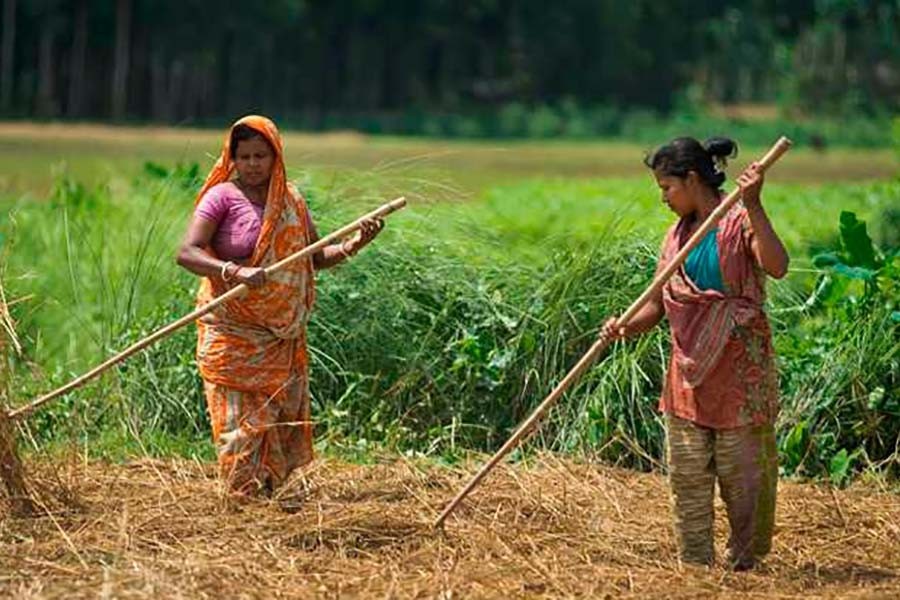Agriculture is still the main driving force in the economy of rural Bangladesh. Food security of a vast segment of the country's population is dependent on headways in the agricultural sector. Agricultural development is linked to poverty alleviation, living standard of the people, employment generation, agro-based industrial growth etc. Its contribution to Gross Domestic Product (GDP) currently stands at 14.10 per cent, while it provides employment to 40.6 per cent of the labour force. The rural economy in the country has become more diverse and dynamic over the past few decades due to its sustained growth. Corporate presences including contract-based production is now clearly visible in the sector. Agro-based industrialisation is bringing dynamism to the country's rural milieu. Against this backdrop, the contribution of womenfolk to the agriculture sector carries much significance.
The involvement of women in agricultural jobs was incorporated for the first time in the labour force survey of 1995-96. Tasks like cattle rearing, poultry farming, paddy husking, boiling and drying, processing and preservation of food were included in it as economic activities. These tasks are mostly carried out by women in the villages. There are also other jobs performed by women that are not viewed as economic activities. The labour force survey of 2005-06 showed that 48.1 per cent of 15-years-plus population in Bangladesh was engaged in the agriculture sector. According to that survey, 41.8 per cent among men and 68.1 per cent among women in the labour force were directly engaged in agricultural work. It showed that the agriculture sector was not only the largest sector with regard to employment generation, it was also the largest arena for women's participation and social dynamism. The participation of men in the agriculture sector has diminished by over 10 per cent during the previous decade. This void has in fact been filled up by female workers.
At present, over 70 per cent of female workers are engaged in the agriculture sector that includes forestry and fisheries. The number of women workers in the sector has increased by over 4.5 million during the previous decade from 3.7 million in 2005-06. Their active participation is noticed in spraying of ash as fertiliser, use of different organic materials on the upper layer of soil, Joom cultivation on the hills, etc. The tangible contribution of women in crop production is estimated to be about 27 per cent. Womenfolk participate in 17 of the 21 stages in crop production cycle. Vegetable production has increased five-folds during the previous few decades due to proliferation of its cultivation mostly by women. They are playing a crucial role in the expansion of horticulture and gardening in the country. They are also environment-friendly and play a supportive role in activities like tree plantation, forestation, land conservation, preservation of bio-diversity, etc.
Although the contribution of womenfolk in agriculture sector is huge, they lack state recognition. According to one estimate, five million among the 13 million unpaid workers added during the previous decade were females. Experts opine that in addition to unpaid family work, 77 per cent rural women work from dawn to dusk in agricultural pursuits alongside their male counterparts. Despite that, the state does not give them due recognition and importance. They have also not been linked to policies and strategies for agricultural development. Although over 14 million farmers' cards have been distributed all over the country, the share of women in these is quite negligible. In the absence of recognition as farmers, they are also not eligible to receive agricultural insurance coverage and other facilities offered by the government.
In addition, women also face wage discriminations compared to men. Their lack of right over family property is also widespread, which remains unarticulated and unresolved. State incentives are urgently needed for establishing the rights of female agricultural producers over inputs including fertilisers and irrigation. They need technical help in the form of training and financial assistance in the shape of credits for sustaining their productive activities. These female farmers and workers in the sector should be accorded due importance and recognition for strengthening and modernising agriculture.
Some recommendations may be put forward for improving the status of women in agricultural work. These include: according recognition to rural women engaged in agriculture as farmers and extending all facilities offered to male farmers; ensuring participation of rural women in the formulation, implementation and evaluation of agricultural development projects and upholding the rights of women over land and its management. More recommendations are: undertaking institutional reforms for ensuring access of female family members in agro-based businesses; providing technical help like training for skills development and financial assistance like credits to rural women for crop-related activities and setting up of agro-based cottage industries and removing wage discrimination between men and women in agricultural work.
Overall, the status of women in the development pursuits of Bangladesh is still not fair and equitable. According to a research conducted by the Centre for Policy Dialogue (CPD), Bangladeshi women spend 16 hours on an average per day in household chores, including informal agricultural work. In monetary terms, this contribution is equivalent to over 601 billion US dollars. If this amount could be added to the country's GDP, then the size of the GDP would have risen considerably. Around 98 per cent of the work performed by men is added to the GDP, while the proportion is only 47 per cent for women. In many instances, the womenfolk play a key role in boosting economic progress, including the growth in agriculture. Therefore, they should be provided equitable opportunities in education, training, healthcare, nutrition, family welfare and social rights, legal cum civic rights and state benefits cum incentives. For this to happen, economic, social, cultural and political obstacles against women's inclusion in the mainstream economy must be removed and discarded.


